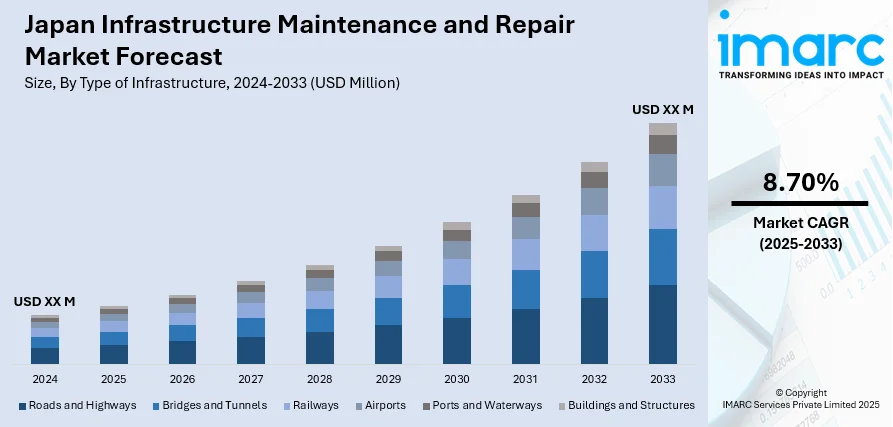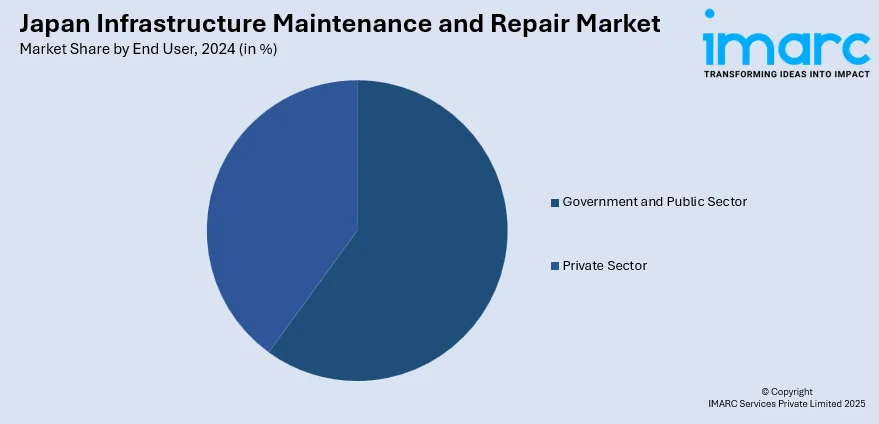
Japan Infrastructure Maintenance and Repair Market Size, Share, Trends and Forecast by Type of Infrastructure, Service Type, Material Used, End User, and Region, 2025-2033
Japan Infrastructure Maintenance and Repair Market Overview:
The Japan infrastructure maintenance and repair market size is projected to exhibit a growth rate (CAGR) of 8.70% during 2025-2033. The market in Japan is driven by the increasing need for maintenance of aging infrastructure, especially in urban areas where rapid urbanization has led to the degradation of transport networks, utilities, and public buildings. Additionally, demand for maintenance and repair services is further enhanced by the government initiatives and public-private partnerships for renovation of infrastructure. Growing concerns about sustainability and safety standards are also prompting investments toward the maintenance of important infrastructure to safeguard it against natural disasters, thus broadly expanding the Japan infrastructure maintenance and repair market share.
|
Report Attribute
|
Key Statistics
|
|---|---|
|
Base Year
|
2024
|
|
Forecast Years
|
2025-2033
|
|
Historical Years
|
2019-2024
|
| Market Growth Rate 2025-2033 | 8.70% |
Japan Infrastructure Maintenance and Repair Market Trends:
Aging Infrastructure and Long-Term Structural Rehabilitation
Japan is under increasing pressure to maintain and upgrade infrastructure built during its post-war economic expansion. Industry reports indicate that by 2033, more than 60% of road bridges and around 40% of tunnels in Japan will have exceeded 50 years of service life, resulting in increased demand for structural rehabilitation. This trend is prompting government agencies to prioritize inspections, lifecycle extension programs, and advanced repair technologies. In addition to this, traditional reactive maintenance is increasingly replaced by preventive and predictive approaches supported by engineering analytics and inspection schedules. Also, municipal and prefectural authorities are under pressure to allocate budgets for the renewal of outdated assets amid fiscal constraints. Furthermore, the Ministry of Land, Infrastructure, Transport and Tourism (MLIT) has issued multiple directives encouraging standardized evaluation methods and the use of corrosion-resistant materials. This reflects a shift from short-term repairs to long-term resilience planning, particularly for transportation and water infrastructure, which is reinforcing the demand for specialized services and certified contractors.

Integration of Digital Monitoring and Smart Maintenance Solutions
The rapid adoption of digital monitoring technologies and sensor-based diagnostics are positively impacting the Japan infrastructure maintenance and repair market growth. IoT-enabled sensors, drones, and 3D scanning tools are now integral to the real-time monitoring of structural health, enabling early detection of anomalies in bridges, tunnels, pipelines, and road surfaces. Apart from this, public agencies are deploying AI-assisted platforms to process large volumes of inspection data and identify deterioration patterns before failures occur. This digital shift aligns with Japan's broader "Society 5.0" initiative, which aims to achieve a super-smart society through the full utilization of technological innovations, including IoT, AI, and Big Data. Additionally, the use of digital twins for modeling infrastructure behavior under stress or aging conditions is gaining traction in urban utilities and transport networks. Private engineering firms are increasingly offering end-to-end maintenance packages that include remote monitoring, cloud-based diagnostics, and automated reporting. As labor shortages persist in the civil engineering sector, such technologies also help reduce dependence on manual inspections, enabling cost savings and improved safety across aging infrastructure.
Regulatory Pressure and Sustainability-Linked Maintenance Programs
Regulatory reforms and sustainability mandates are playing a larger role in shaping market development. Revised infrastructure laws and urban renewal guidelines require more frequent inspections and standardized maintenance reporting from local governments and private operators. These regulations cover a wide range of assets, including roads, dams, sewerage systems, and public housing. In parallel, environmental sustainability considerations are influencing how maintenance projects are planned and executed. Authorities are pushing for the use of low-carbon materials, energy-efficient repair technologies, and climate-resilient construction methods. Green procurement standards are being incorporated into public tenders, favoring contractors with certified environmental practices. Moreover, disaster preparedness and climate adaptation are emerging as policy priorities, especially in coastal and earthquake-prone regions. As a result, maintenance service providers must align offerings with evolving policy goals around decarbonization, risk mitigation, and lifecycle efficiency.
Japan Infrastructure Maintenance and Repair Market Segmentation:
IMARC Group provides an analysis of the key trends in each segment of the market, along with forecasts at the country and regional levels for 2025-2033. Our report has categorized the market based on type of infrastructure, service type, material used, and end user.
Type of Infrastructure Insights:
- Roads and Highways
- Bridges and Tunnels
- Railways
- Airports
- Ports and Waterways
- Buildings and Structures
The report has provided a detailed breakup and analysis of the market based on the type of infrastructure. This includes roads and highways, bridges and tunnels, railways, airports, ports and waterways, and buildings and structures.
Service Type Insights:
- Preventive Maintenance
- Corrective Maintenance
- Predictive Maintenance
A detailed breakup and analysis of the market based on the service type have also been provided in the report. This includes preventive maintenance, corrective maintenance, and predictive maintenance.
Material Used Insights:
- Concrete Repair
- Asphalt Repair
- Steel Repair
- Composites and Polymers
The report has provided a detailed breakup and analysis of the market based on the material used. This includes concrete repair, asphalt repair, steel repair, and composites and polymers.
End User Insights:

- Government and Public Sector
- Private Sector
A detailed breakup and analysis of the market based on the end user have also been provided in the report. This includes government and public sector and private sector.
Regional Insights:
- Kanto Region
- Kansai/Kinki Region
- Central/Chubu Region
- Kyushu-Okinawa Region
- Tohoku Region
- Chugoku Region
- Hokkaido Region
- Shikoku Region
The report has also provided a comprehensive analysis of all the major regional markets, which include Kanto Region, Kansai/Kinki Region, Central/Chubu Region, Kyushu-Okinawa Region, Tohoku Region, Chugoku Region, Hokkaido Region, and Shikoku Region.
Competitive Landscape:
The market research report has also provided a comprehensive analysis of the competitive landscape. Competitive analysis such as market structure, key player positioning, top winning strategies, competitive dashboard, and company evaluation quadrant has been covered in the report. Also, detailed profiles of all major companies have been provided.
Japan Infrastructure Maintenance and Repair Market News:
- On February 18, 2025, INFRONEER Holdings and Accenture announced the formation of a joint venture, INFRONEER Strategy & Innovation, to address critical challenges in Japan's construction and infrastructure sectors. Scheduled to commence operations in April, the partnership targets to improve productivity and efficiency through the application of advanced digital technologies, including AI, and to develop data-driven management models across infrastructure projects. This collaboration seeks to modernize infrastructure operations, improve safety, and address labor shortages exacerbated by Japan's aging population and fiscal constraints.
Japan Infrastructure Maintenance and Repair Market Report Coverage:
| Report Features | Details |
|---|---|
| Base Year of the Analysis | 2024 |
| Historical Period | 2019-2024 |
| Forecast Period | 2025-2033 |
| Units | Million USD |
| Scope of the Report |
Exploration of Historical Trends and Market Outlook, Industry Catalysts and Challenges, Segment-Wise Historical and Future Market Assessment:
|
| Type of Infrastructures Covered | Roads and Highways, Bridges and Tunnels, Railways, Airports, Ports and Waterways, Buildings and Structures |
| Service Types Covered | Preventive Maintenance, Corrective Maintenance, Predictive Maintenance |
| Materials Used Covered | Concrete Repair, Asphalt Repair, Steel Repair, Composites and Polymers |
| End Users Covered | Government and Public Sector, Private Sector |
| Regions Covered | Kanto Region, Kansai/Kinki Region, Central/Chubu Region, Kyushu-Okinawa Region, Tohoku Region, Chugoku Region, Hokkaido Region, Shikoku Region |
| Customization Scope | 10% Free Customization |
| Post-Sale Analyst Support | 10-12 Weeks |
| Delivery Format | PDF and Excel through Email (We can also provide the editable version of the report in PPT/Word format on special request) |
Key Questions Answered in This Report:
- How has the Japan infrastructure maintenance and repair market performed so far and how will it perform in the coming years?
- What is the breakup of the Japan infrastructure maintenance and repair market on the basis of type of infrastructure?
- What is the breakup of the Japan infrastructure maintenance and repair market on the basis of service type?
- What is the breakup of the Japan infrastructure maintenance and repair market on the basis of material used?
- What is the breakup of the Japan infrastructure maintenance and repair market on the basis of end user?
- What is the breakup of the Japan infrastructure maintenance and repair market on the basis of region?
- What are the various stages in the value chain of the Japan infrastructure maintenance and repair market?
- What are the key driving factors and challenges in the Japan infrastructure maintenance and repair market?
- What is the structure of the Japan infrastructure maintenance and repair market and who are the key players?
- What is the degree of competition in the Japan infrastructure maintenance and repair market?
Key Benefits for Stakeholders:
- IMARC’s industry report offers a comprehensive quantitative analysis of various market segments, historical and current market trends, market forecasts, and dynamics of the Japan infrastructure maintenance and repair market from 2019-2033.
- The research report provides the latest information on the market drivers, challenges, and opportunities in the Japan infrastructure maintenance and repair market.
- Porter's five forces analysis assist stakeholders in assessing the impact of new entrants, competitive rivalry, supplier power, buyer power, and the threat of substitution. It helps stakeholders to analyze the level of competition within the Japan infrastructure maintenance and repair industry and its attractiveness.
- Competitive landscape allows stakeholders to understand their competitive environment and provides an insight into the current positions of key players in the market.
Need more help?
- Speak to our experienced analysts for insights on the current market scenarios.
- Include additional segments and countries to customize the report as per your requirement.
- Gain an unparalleled competitive advantage in your domain by understanding how to utilize the report and positively impacting your operations and revenue.
- For further assistance, please connect with our analysts.
 Request Customization
Request Customization
 Speak to an Analyst
Speak to an Analyst
 Request Brochure
Request Brochure
 Inquire Before Buying
Inquire Before Buying




.webp)




.webp)












